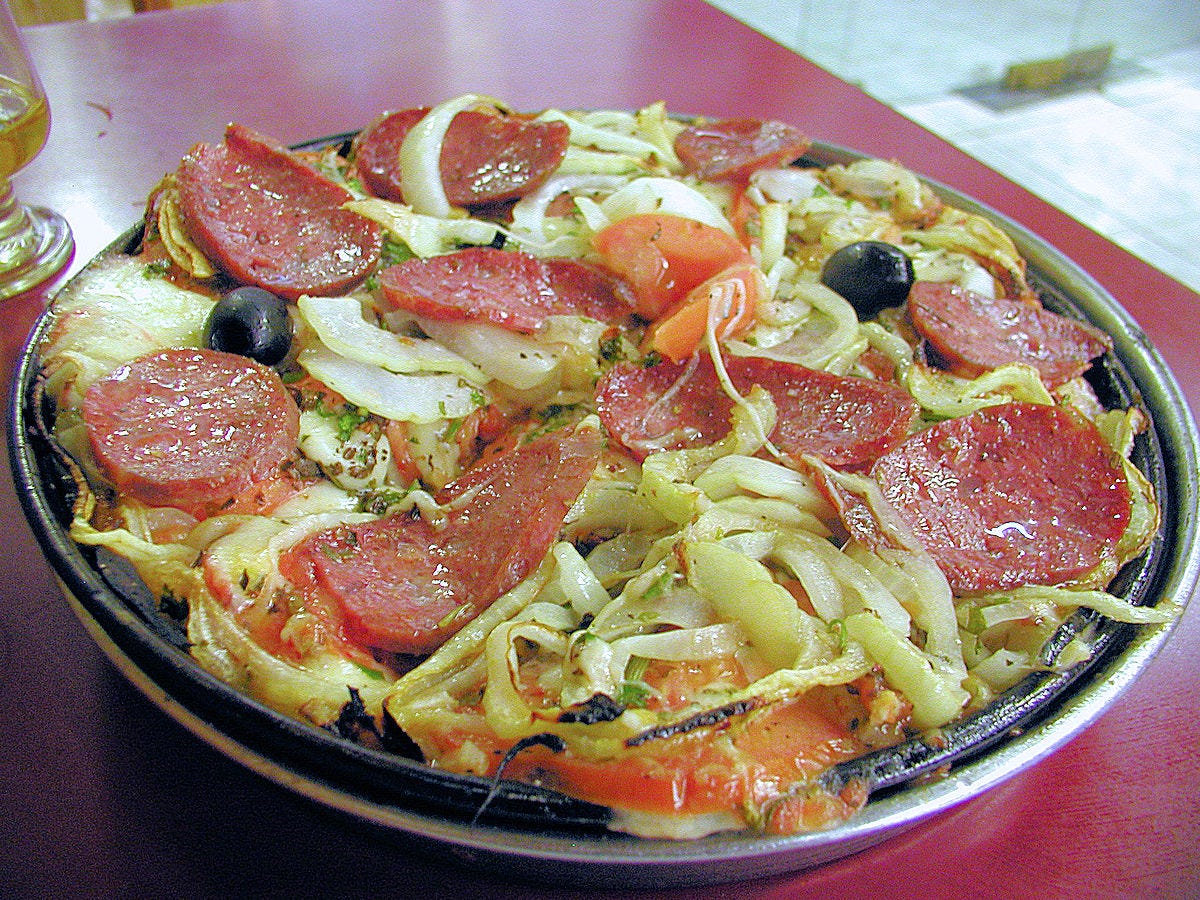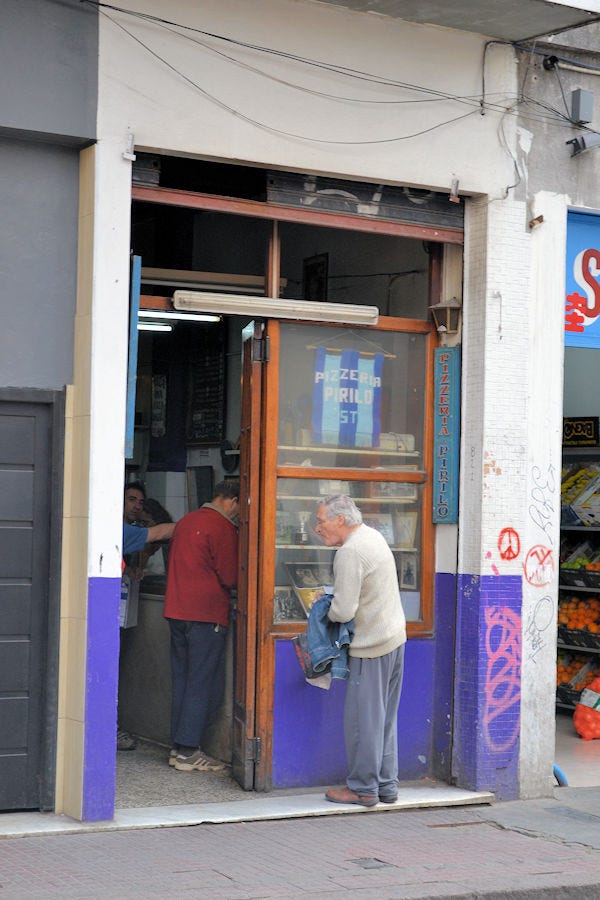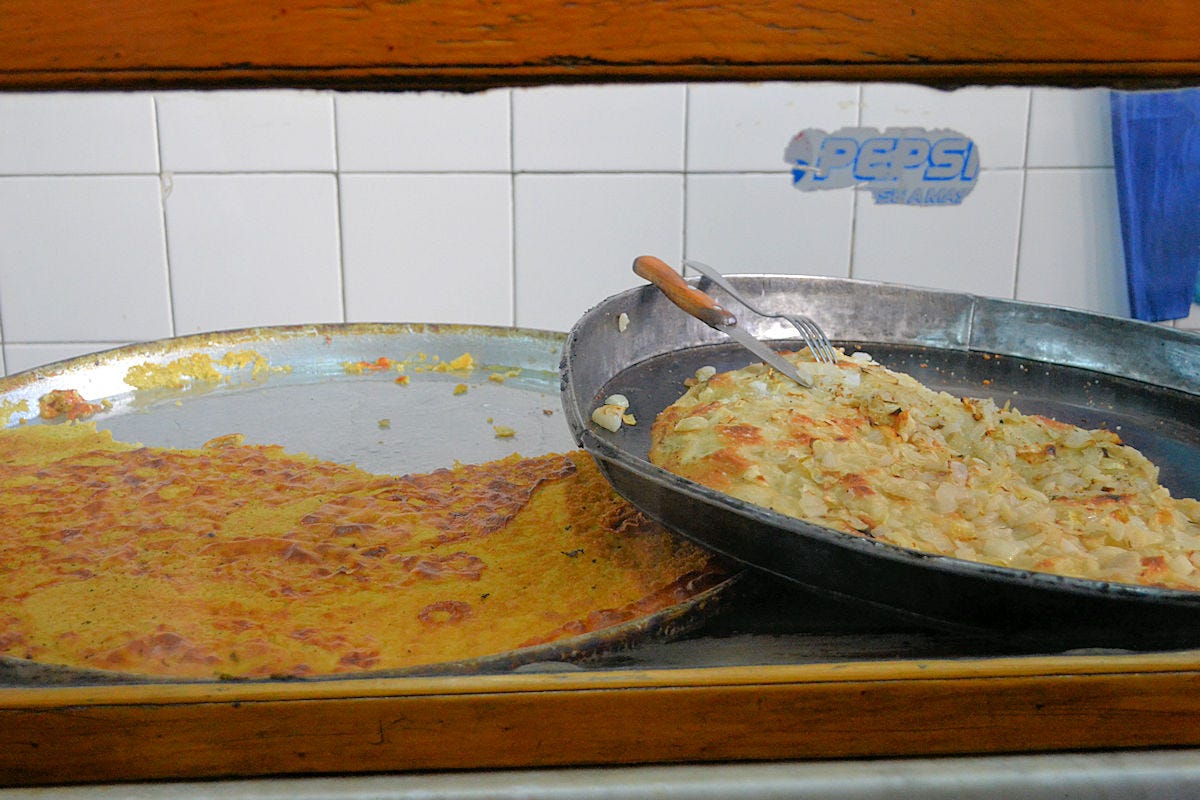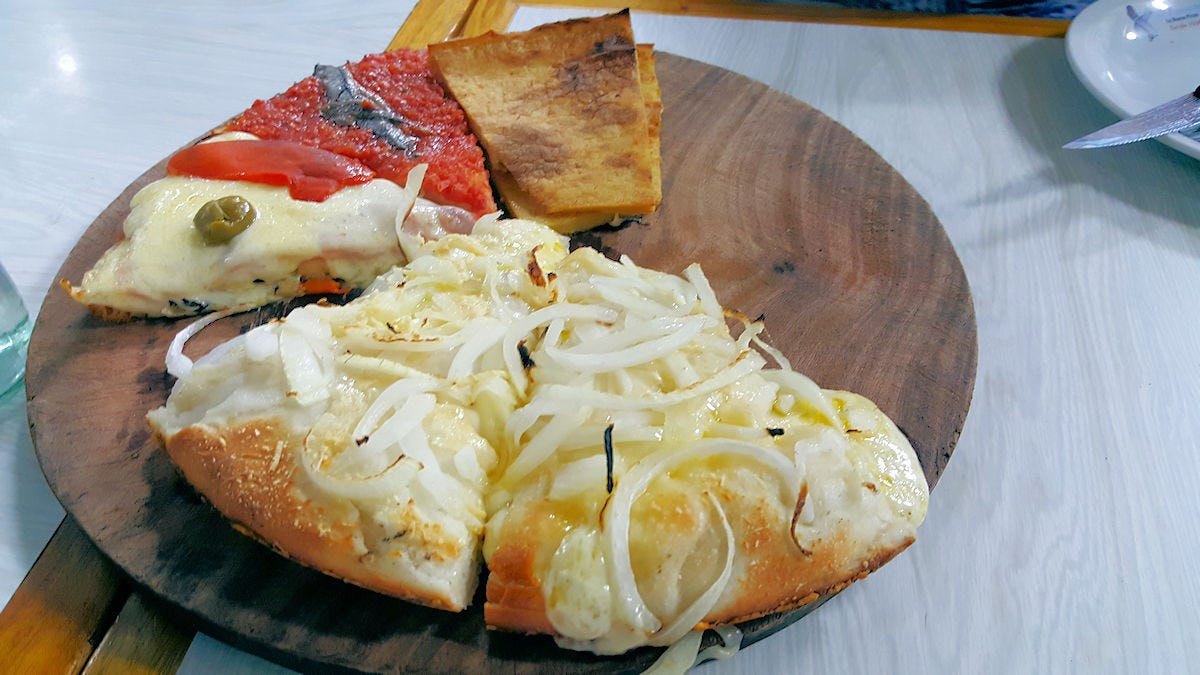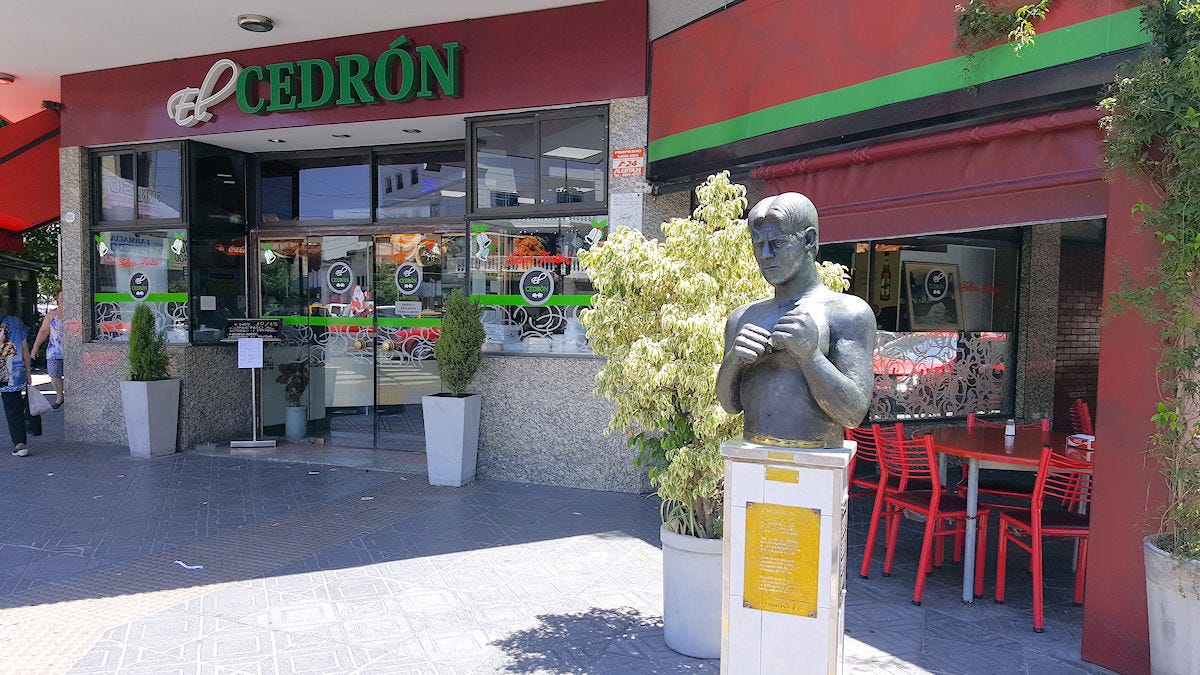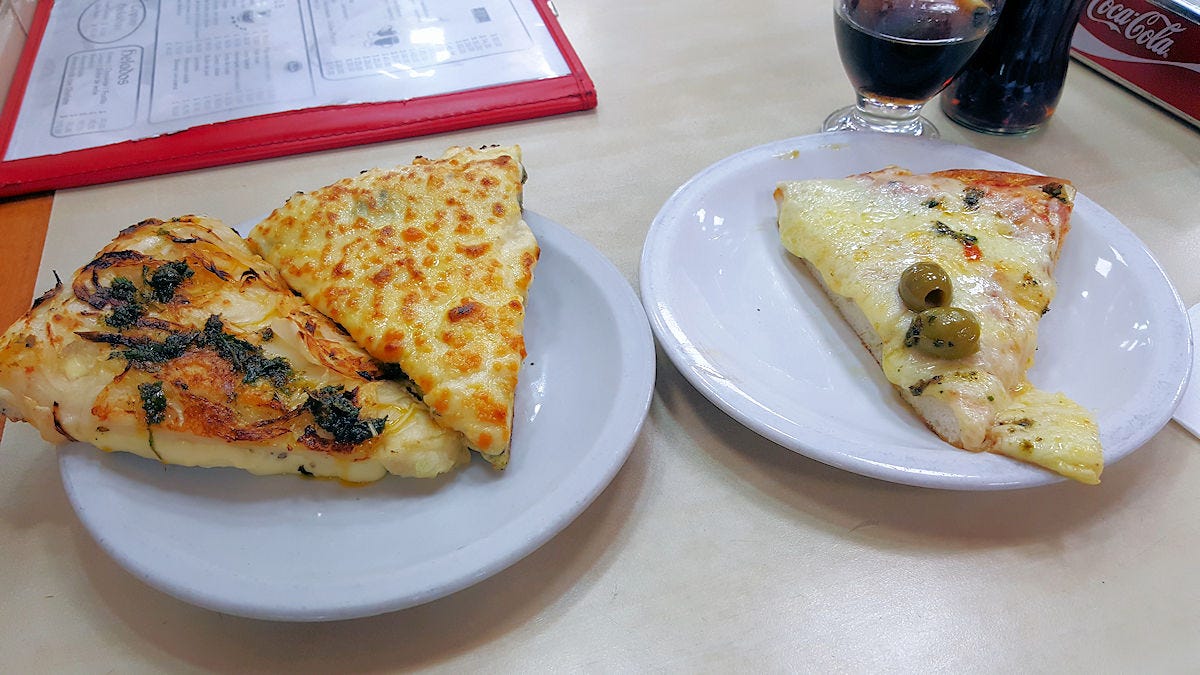Tatterdemalion or Admirable?
In which I continue exploring the most historical pizzerias in town, and test my own ability to come up with synonyms for the title.
I know that yesterday I said I was taking La Nación at their word for having researched and come up with the ten oldest pizzerias in town. But then I started thinking about some of the older pizzerias I’ve been to over the years, and a few minutes in online searching and I came up with three that are as old as those that the newspaper selected. So I’m throwing those in the mix of these posts and we’ll see where this all goes.
1932 - Las Cuartetas, Av. Corrientes 838, San Nicolás
Originally opened at the corner of Av. Corrientes and Libertad by a pair of Spanish immigrants, Luis Urcola from the Basque region and José Espinach from the Catalán region. I’m not sure what the original name was, but at some point it was changed to Las Cuartetas, perhaps after it moved a few years later to its current spot, the apocryphal story being that local tango poet Alberto Vacarezza used to be a regular and would sit in the corner and compose his cuartetas, or quatrains. In 1957 the partners were bought out by a group of their employees, and the place continues to operate as a workers’ collective. I’ve never been fond of the service in the place, which always feels a bit condescending and often bordering on rude. Apparently, I’ve never taken a photo of the place (nor at several others today), so, on to the pizza.
On offer here is the option of either a la piedra - a more or less thin crust pizza ostensibly cooked on the piedra, or stone, more likely just on the floor of the deck oven; or al molde, a deep dish pizza in a cast iron mold. I usually opt for the latter, and my favorite over time is their super napoli, about which, on first go-round, I thought: a true deep-dish pizza, still sizzling from the oven, was unceremoniously dumped placed on the table. Even from just the smell I could tell I was in for a treat. The crust was near perfect, a little crispy and crunchy on the bottom and edges, soft but not doughy above. Plenty of toppings – thick slices of ripe tomatoes, rings of onions, longaniza sausage, herbs, spices, garlic, and… good quality, gooey, stringy, and not oily, mozzarella cheese. I think we finished off the pizza before he’d made it back to his waiter station.
1932 - Pirilo, Defensa 821, San Telmo
Here, I’m straying from La Nación’s list. It’s actually pretty hard to believe they missed this one. Originally opened in 1932 as Luigin, the name of a family cousin, the name was changed to Pirilo in 1934, the nickname of another cousin. Family drama, no doubt.
This place is an “experience”. Officially, it’s open from 2-11pm, every day but Monday, but that’s complete nonsense as best I can tell. Somewhere around noon, people start kind of casually gathering near to it. It’s a teeny little space, if you put tables in there you might fit a table for four and a table for two. But it’s all standing room only. Somewhere around 12:30, or 1:00, or maybe 1:30, someone will come out through the partially open metal security gate, and quickly raise it up. By that time, there will be enough people gathered around to quickly fill the space. There’s not much order to it all, unlike the usual porteño, happy to wait in line process, here, you just jam your way to the counter, order, and pay, and then fight your way to pick up what you ordered, find a place to stand, inside or out, and eat. It’s like being in a subway train at rush hour, with food. And, generally, within a very short time, usually about an hour to an hour and a half, they’re sold out of everything they’ve made, and they don’t make more. Gradually, everyone drifts out the door, and the gate comes down. I gather the experience is repeated in the evening, though I’ve never headed there then.
The choices are few. Mozzarella. Anchovy (without cheese). Ham and Pepper (with cheese). Fugazza. Fugazza con queso. Fainá. That’s it. By the slice to eat there, or a whole pie, small or large, to go. For the pizza by “the slice”, they make them in huge, 60cm molds, and then cut pieces in more or less random shapes of more or less the same size and served up on a minuscule paper napkin. Is it worth it? No. Not really. It’s perfectly acceptable pizza, and even a decent fainá (chickpea and cheese “bread” that’s often used as a second dough topping to pizza here). And it’s among the better in San Telmo, but honestly, that’s a low bar. As I said, it’s an experience, and if you want to do something truly authentically Argentine for pizza, it’s worth a visit, once.
1934 - El Cuartito, Talcahuano 937, San Nicolás
Originally a tiny room (a cuartito), barely a stall for serving pizza to go, next door to the current address. The trio of friends who opened the space set a goal, and a motto which remains to today, to “try to make good pizza”, which is not exactly a highly motivating vision statement. At some point they bought the neighboring restaurant, Talcahuano, and expanded into being a full-on, dine-in pizzeria. The walls are festooned with photos and memorabilia of sports, literature, music, and other cultural icons. It was one of the first pizzerias that I ever tried here in town, and initially, I really didn’t like it, and the fact that it was touted by every tourism and tour guide in the city didn’t make it appealing.
My first visit: I ordered a small pizza mixta, a specialty of the house – half plain mozzarella, half anchovy. The crust is fine, if a little bland. The tomato sauce is fresh, and clearly made from chopped tomatoes and garlic. And nothing else. There’s not another hint of spice or seasoning or herbs. The mozzarella, thankfully gracing only half of the pie is as oily as the aftermath of the Exxon Valdez. Come on folks, there’s so much better pizza in this city that this is inexcusable. If this place once served exceptional pizza, that day has clearly passed.
And, the latest visit, a few years ago: We ordered up a couple of pieces of my new passion, fugazzetta, and a napolitana for her and an anchoa for me, plus, a couple of pieces of faina. In short order they arrived, and I have to say, they were all pretty good. The biggest change, the cheese is actually rather good quality now, there were no oil slicks, there was no dripping grease, and the flavor was decent. Likewise, the crust had some flavor, and the faina was served piping hot and while not the best I’ve had of this staple, it was good. So, over time, for me, this place went from an “okay” to a “not recommended”. At the very least I think it deserves being returned to “okay”, and maybe even edging into “good”. At least, I’m not going to avoid it like the plague anymore or tell people they shouldn’t bother.
1935 - El Cedrón, Av. Juan Bautista Alberdi 6101, Mataderos
I’m straying from La Nacion’s list again, but being a bit iffy here. There was a time, many moons ago, 1908 to be a bit more precise, when the public transit system of the city consisted of a good number of streetcars, or trams, and at the corner of Alberdi and Murguiondo, where the #40 and #48 lines came together, one Ambrosio Cremella opened up a sort of after-office bar and eatery, La Primera Curva, “The First Bend”, where those on their way home from the city center could grab a bite or a drink with friends before continuing home (Mataderos was, at the time, perhaps a bit more desirable part of the city to live in). For two decades it was “the place” in the area. In 1930 he retired and sold the bar and over the next few years it lost its luster. In 1935 it was sold again to one Don Manuél Cedrón who restored it to its preeminence, added pizza to the menu, and ran it successfully until 1966, when he and his family decided that the era of the bodegón had passed, and spiffed the place up, modernized it, and converted it to a pizzeria, now known as El Cedrón. Apparently a big fan of lightweight boxing champion Justo Suárez, there’s a bust of him out front. So, does it count as having been a pizzeria starting in 1935 when they were among the early places to start offering pizza in town, and certainly the first in that entire area of the city, or would we only count it from 1966? I’m throwing it into the mix, just because.
Damn, it’s good. It’s really good. The plain mozzarella slice isn’t all that to get worked up about, but it’s well made, it has enough sauce, and a good one, to taste, it’s got good cheese, pitted olives, and great crust. But the two slices that get touted over and over are the fugazzetta, and the espinaca. You’ve already met the former in my recent writings, but El Cedrón takes it into completely new territory. I couldn’t tell you exactly what’s on it, but if I were to guess, they’ve topped the dough with a sort of tangy creamy cheese, maybe cuartirolo, then a layer of mozzarella, then liberally strewn with thin slices of onions, and then the crowning touch, they cover the whole thing over with spoonfuls of housemade chimichurri and stick it in the oven to brown and get pretty amazing. The latter slice, the spinach, comes with “white sauce”, a bechamel, then a layer of finely chopped cooked spinach, and finally a thin layer of mozzarella over the top, which once again is broiled to perfection (why can’t they do that to the mozzarella slice, it would be so perfect?). Easily the best white spinach pie I’ve had since, well, this will mean nothing to most people, Jan Tropean used to make them at The Eagle’s Nest gay bar in West Orange, NJ, back in the 80s. And those were some good pizzas.
1938 - Angelín, Av. Córdoba 5270, Villa Crespo
The place had acquired something of a mystique, and I’m not entirely clear why. I heard stories of them using “secret” types of wood in their wood-fired oven, of just as secret recipes for their crust and their sauce. They’re famous for their pizza canchera (which means “savvy” or “streetwise”), which they claim to have invented – it’s a pizza with just dough and sauce… no cheese, no other toppings… I’m afraid I can’t go along with giving them credit for having “invented” such a thing – perhaps they were the first in Buenos Aires to serve a pizza with just dough and sauce, but long before their was an Argentina, the Italians were doing the same thing back in Napoli… and, perhaps, most importantly for some, they are legendary for being “Frank Sinatra’s favorite”, right down to an autographed photo on their wall from him… which doesn’t affirm his favor, just that he’d tried their pizza… and a bit of digging turns up that Frankie only graced Argentina with one visit in his career, in August 1981, where he put on five performances over five nights. I can’t say how many of those nights he graced Angelín with his presence, or if, perhaps, he simply had the pizza delivered to his hotel, but it would seem to me that five days is a bit short to have decided on a favorite pizza in the city. But, such are the few threads of which legends are woven, no?
Regardless, the pizza is pretty darned good. We tried a half and half canchera, just to see what the fuss is all about, and classic napolitana. The crust is good, nice and browned on the bottom and not at all doughy, though, in my view, a little bland. The sauce is great, it really is – packed with herbs and garlic – one of the better sauces I’ve had, and certainly makes the canchera a worthwhile offering, since that’s where all the flavor comes from. The napolitana was a little less interesting, though still good – it had a modicum of the sauce, just enough to give a touch of the herbal flavor, and a lot of fresh tomatoes and a decent amount of cheese – and not a bad pizza mozzerella, though not top of the line. Overall, definitely recommended, and the atmosphere is great – old-time style, with lots of character, and, of course, you can look at Frankie’s photo.
Stopping here for today - I’ll finish up with the last five I’ve got to cover tomorrow - which adds in an extra three (two covered today) over the newspaper’s list.


